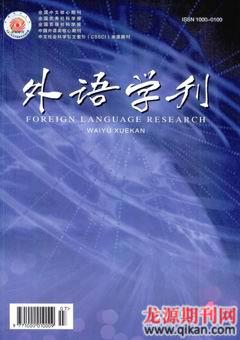汉英“跑+名/run+n.”搭配的对比研究
钟珊辉
提 要:本文基于一定数量的实际语料,从分析语义成分入手,对比分析汉英“跑+名/run+n.”搭配的异同。研究发现:无论是基本义还是隐喻义用法,“跑+名/run+n.”搭配差异都很明显,异远大于同。“跑+名”的语义组合是“受事/承受对象、结果、时间、方式和处所”;run+n.的语义组合没有“方式”,只有run复合体才接处所名词,其他跟汉语有相同的语义成分。在分析搭配差异原因的同时,本文还指出探讨英汉词汇搭配差异对英语教学有启示作用。
关键词:动名搭配;语义分析;跑;run
中图分类号:H030文献标识码:A文章编号:1000-0100(2009)04-0059-3
AContrast Study on the Collocation of“Pao+Ming”vs.“Run+N.”
ZhongShan-hui
(Hunan College of Finance and Economics, Changsha410205, China)
Based on a certain amount of Chinese and English corpora and through the semantic analysis, this paper makes a comparative and contrastive study on collocation differences and similarities between “Pao+Ming”and“run+n.” and also reaches some ideas: whether on the primary or metaphorical meanings, the collocation differences between the above two are apparent and the differences are far greater than the similarities. The semantic collocation of “Pao+Ming”isObject, Result, Time, Manner and Location; “run+n.”has much the same semantic collocation as “Pao+Ming”exceptManner and Location,for noMannerexists in “run”andOnly verb complex of “run” can be followed by Location nouns. Also in this paper some reasons are listed for the collocation differences and attention is called to these differences between Chinese and English in English teaching.
Key words:verb-noun collocation;semantic analysis;Pao;run
1 “跑+名词”与“run+n.” 搭配的异同
我们基于北京大学汉语语言研究中心现代汉语语料库,检索“跑”,共得46573条结果,其中我们手工分析了10000条,几乎涵盖了“跑”后的所有“动后语”。英语语料为英国BNC的文字材料,动词 run 频现近4万词次,(British National Corpus freq.=38882),其中及物动词为12051(占31%);run是表示运动事件的动词,词根动词run还常和其外围成分如小品词结合,再接宾语,这样的动词复合体(verb complex)共出现 9581次(占25%)。我们对两个语料库中“跑/run”的及物性意义作了详细梳理,以便能对比出汉英语言中的动名搭配差异。现列述如下。
1.1 “跑/run”用作“急走”基本义与名词/n.的搭配及对比
“跑”,趵也——《广雅•释言》,意思是:急走。例如“红缰跑骏马,金镞掣秋鹰”——唐• 马戴《边将》,此“跑”有致使义,为“使骏马跑”;run作及物动词时,在Merrian-Websters Online Dictionary中的释义为:to cause(an animal) to go rapidly. 故“跑/run”的基本义相同。
(1)“跑/run”+“受事/对象”类名词。这些名词主要指动物,如“红缰跑骏马”。现代汉语里,“跑”+受事/对象类名词不多,意义也有所变化,如“跑马”,指为参加赛马而养育和训练的马,是名词;run+受事/对象的搭配范围很广,动物名都可接,如run a horse, run a bull,run sheep(放牧马/牛/羊);run a horse(骑着马跑)或run a horse in a race(让马参加比赛)等。搭配意义随语境而变化,但表现的都是“致使”本义,意为“使……跑”。
(2)“跑/run”+“承受者”类名词。这些名词包括与“跑/run”这一人类生存的基本活动相关的地点和场所。“跑”可用于“跑山路、跑这条道、跑地”等,意为“在山路上/这条道上/地上跑”;run可用于run the street(在街上玩耍),run the field(在田野上玩)等。同接承受类名词,但互译时表面形式并不对等:“跑山路” 译为run on the mountain road; run the street译为“在街上玩耍或疯玩”,run意义也变为“自由地/随心所欲地跑”。
(3)“跑/run”+“结果”类名词。这些名词说明了“跑/run”后的结果。“跑”可用于“跑一趟、跑二圈、跑9公里、跑第一、跑几步”等;英文里也有对应的搭配,如run two circles, run 9 kilometers, run first, run a few steps, 但“跑一趟”英语为run across to...(去……跑一趟)。另外,汉语在表达“跑”的结果时有很丰富的表达,如“跑得他上气不接下气,跑得他满头是汗,跑得累死了,跑断了脚,跑酸了腰,跑丢了鞋”等。汉语“跑”用特征宾语,即动词和其后的名词来说明主语的特征;run后却一定要有宾语,如run oneself out of breath, run himself full of sweat,run himself to death,run oneself off his legs,表现的是“致使”本义,意为“使跑/奔”。有的只能寻求意义表达对等,如have a backache due to running,my shoes are off my feet due to running.
(4)“跑/run”+“时间”类名词。这些名词体现了实现“跑”的动作或状态所用的时间或“跑”发生的具体时间点,如“跑一天,跑二个小时,跑三点半”等;动作或状态的完成,要加辅助词“了”,如“跑了一个月”;run也可用于run a day, run two hours, run at half past 3, 但表示动作或状态的完成时,run在时体上要有所体现,如I have run for a month.

